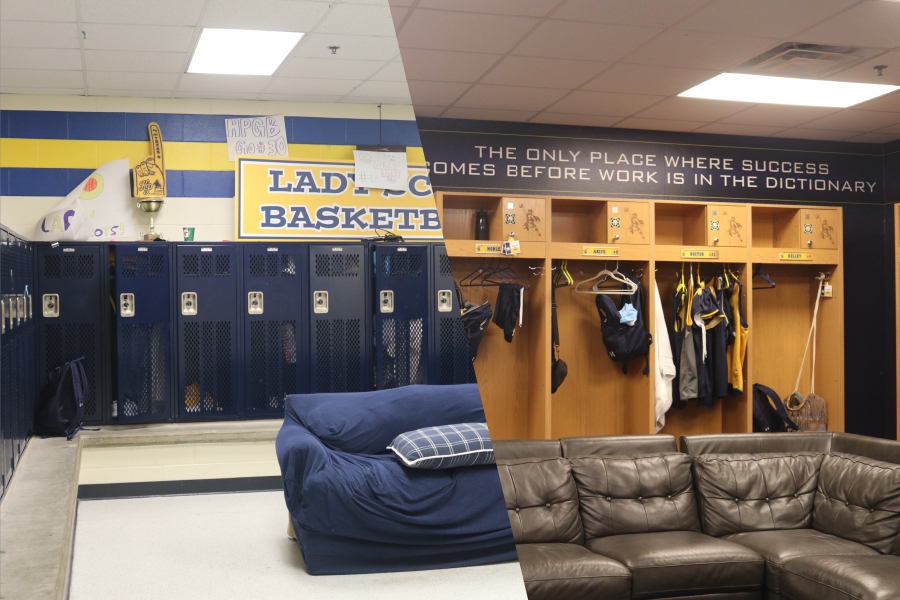The girls’ volleyball, basketball, JV cheer, and softball locker rooms at the high school have not been updated for almost a decade. Three of these four teams share one locker room, and the fourth is little more than a small storage closet in a basement. Meanwhile, the male counterparts to these teams, such as the baseball team, have relatively newly renovated locker rooms.
Emma Wang, a senior varsity volleyball player, feels very strongly about the locker room issue in the school, and even further the difference in funding. She believes it hurts volleyball morale, leading to more social tension.
“I just don’t understand why they would have more funding,” Wang said. “Female sports are just as important.”
For many athletes, the condition of their locker rooms can make a significant difference in their overall experience, with female athletes saying they feel the girls’ teams aren’t given the same attention, resources, or funding as the boys’ locker rooms are.
“It definitely just affects our morale,” Wang said. “It just makes us feel less important.”
The girls’ locker rooms at the school are sometimes viewed as overcrowded and underfunded. Wang mentioned that female athletes have to share their space with multiple other teams such as cheer, volleyball, and basketball.
“They definitely don’t compare as far as space goes,” Wang said. “ Like varsity basketball and varsity football have their own space, and they don’t have to share. Even varsity cheer and the belles have a lock on their door, and they’re the only ones who know the code to that.”
The cramped conditions are a source of frustration for the athletes, especially since the boys’ locker rooms tend to be more spacious. For example, varsity sports like basketball and football have dedicated spaces that only those teams can use, whereas girls’ teams often share their facilities with others. The inequity in space and privacy makes the female athletes feel less valued. Even further the lack of privacy can be concerning to the athletes.
“I’ve talked to some of my teammates about it, and we just think it’s not fair. It’s just kind of annoying that they get more than us,” Wang said.
In addition to cramped locker rooms, the girls’ teams often feel neglected in terms of resources and funding. Female athletes have reported issues such as subpar transportation, inadequate fridges, and limited budgets compared to their male counterparts.
“They have better buses than us, or they might keep their fridges more stocked,” Wang said.
Even something as simple as the size of the grocery check for team snacks seems to be larger for the boys’ teams. These small but significant differences add up, creating a feeling that girls’ sports aren’t as prioritized. However, not all girls’ teams feel they have been left behind. The Belles have a locker room that is considered one of the better girls’ facilities. While it isn’t perfect, with occasional issues like clogged toilets and a lack of paper towels, the area is relatively spacious compared to the locker rooms of other women’s’ teams.
“It’s really not that bad,” junior Belle Meg Beale said. “Still, with a team of almost 85 members the lack of room is still an issue, especially when the locker room becomes crowded in the mornings before practice.”
Despite these frustrations, efforts have been made to improve the conditions for female athletes. The administration has been trying to make the boys and girls locker rooms the same in size and looks according to Jeremy Gilbert, the school’s athletic director.
“When the school used bond money to build new locker rooms for both boys and girls, the intention was to create equal spaces.” Gilbert said. “The boys’ and girls’ locker rooms were built to be identical in size and quality.”
He added that while the bond ensured both of the recently upgraded locker rooms were the same size, booster clubs, which raise money to fund upgrades, have made a significant difference in the facilities.
“The girls’ soccer team raised money to make their locker room bigger, even surpassing the size of the boys’ locker room,” Gilbert said.
While improvements have been made, there are still significant disparities in how boys’ and girls’ sports are supported according to female athletes that add up to an overall feeling of inadequacy.
“Boys’ sports are a lot more praised, like at pep rallies and stuff, compared to girls,” Beale said. “I really don’t think any girls’ sports, especially like volleyball which is kind of a bigger deal, get praised at all. And it should be.”
Gilbert acknowledged that there have been efforts to balance things out but recognized the challenge.
“I know there’s a belief that football gets everything and everybody else fights for what’s left, but I don’t value my football players more than my cross country runners or my softball players,” Gilbert said. “I make sure each program has a facility they can be proud of.”
As for the future, there are plans to continue upgrading the facilities for girls’ teams.
“For the girls’ softball team, we’re going to upgrade their facility this summer,” Gilbert said. “It’ll include a changing room, which will be similar to what cheer has. We’ll also be upgrading the indoor facility next to this building with new turf, lighting, and paint.”
The disparities in athletic facilities, including locker rooms, highlight the ongoing struggle for gender equality in sports.
“I assure you, as the director of athletics, girls’ sports are just as important to me as boys’ sports,” Gilbert said. “I have a son and a daughter, and I’ve seen how extracurricular activities have impacted their lives. I understand the role that locker rooms, practice facilities, fields, uniforms, and all of that play in ensuring a high-quality experience for every student-athlete, and that’s something I’m committed to.”




